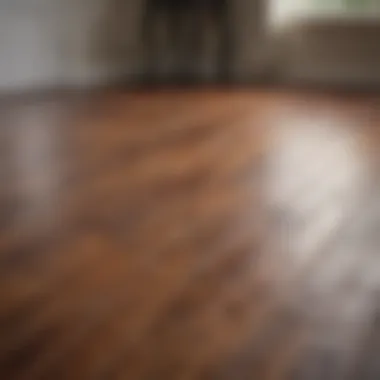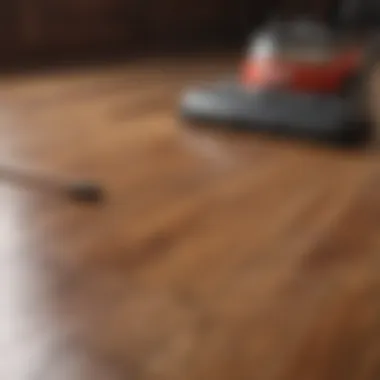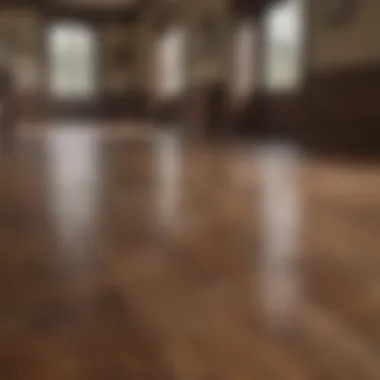A Comprehensive Guide to Washing Hardwood Floors


Intro
Washing hardwood floors is an essential task for maintaining their aesthetic appeal and ensuring their longevity. Proper maintenance not only enhances the beauty of the wood but also protects the investment homeowners have made in their flooring. With different types of wood and finishes, knowing the right techniques can make a significant difference in cleanliness and durability.
This guide presents a methodical approach to washing hardwood floors. It includes necessary tools, recommended techniques, and maintenance tips tailored for various types of hardwood. Additionally, potential challenges and pitfalls are discussed to help avoid common mistakes. Understanding these factors will empower homeowners and interior design enthusiasts to care for their floors effectively.
Properly maintained hardwood can last decades, blending seamlessly with the decor of the home. As we delve deeper into the guide, we will outline best practices and equip you with the knowledge you need for successful floor maintenance.
Home Features
Hardwood floors provide a warm, inviting feel to any home. Their natural texture and diverse finishes contribute significantly to the overall aesthetic of interior spaces.
Architectural Marvels
Wooden floors are often highlighted in various architectural styles. From traditional to contemporary designs, the type of wood and installation pattern can make a striking difference. Some of the most admired hardwood varieties include oak, maple, and cherry.
Each type carries its own unique grain and coloration, contributing to interior character. For instance, oak is well-known for its durability and attractiveness, while maple offers a lighter option that can brighten spaces.
Unique Design Elements
Attention to detail in design can elevate the appeal of hardwood flooring. The choices in finishes — matte, satin, or glossy — all affect how the floor appears under different lighting conditions. Decor elements can complement the floor, enhancing its beauty and creating a cohesive look across the room.
Some homeowners opt for area rugs to define spaces while protecting high-traffic areas. Maintaining a balance between the wood's natural beauty and the surrounding decor is key for a harmonious interior.
Interior Design Inspirations
When considering how to enhance your hardwood floors, various design aspects come into play. Color schemes and furniture arrangements impact not just the visual appeal but also the function of a space.
Color Palettes and Themes
Colors in a room can either accentuate or detract from the floors. Neutral palettes can provide a perfect backdrop for vibrant wooden tones, ensuring the wood becomes a focal point rather than competing with bold colors.
Warm color palettes, such as earthy tones or soft whites, can create an inviting atmosphere, enhancing the natural look of the wood.
Furniture Arrangement Tips
Arranging furniture thoughtfully can help protect floors from scratches while enabling easier cleaning. Keeping heavier pieces on felt pads minimizes wear, while maintaining clear pathways can simplify the washing process.
By considering these aspects, homeowners can not only achieve aesthetic pleasure but also practical living conditions that extend the life of their hardwood floors.
Understanding Hardwood Floors
Understanding hardwood floors is vital for anyone looking to maintain their elegance and functionality in residential and commercial spaces. This article provides insights into the types and characteristics of hardwood flooring, laying a foundation for effective cleaning and care practices. Knowing the specifics regarding hardwood can help homeowners make informed decisions about cleaning techniques, products, and overall maintenance.
Types of Hardwood Flooring
There are two main categories of hardwood flooring: solid hardwood and engineered hardwood. Solid hardwood is made from a single piece of timber, which provides durability and can be refinished multiple times. Common species include oak, maple, and cherry. Each type has unique grain patterns and colors, contributing distinctively to interior design.
Engineered hardwood consists of several layers, with a veneer of real hardwood on top. This construction offers enhanced stability, especially in areas with fluctuating humidity. Varieties include hickory and walnut, both of which are popular in modern design schemes. When selecting the type of flooring, consider factors such as installation location, moisture exposure, and overall style preferences.
Characteristics of Hardwood
Hardwood floors are appreciated for their natural beauty, warmth, and timeless appeal. The key characteristics include:
- Durability: When properly maintained, hardwood can last for decades without significant wear. This is due to its robust structure and natural resilience.
- Aesthetic Value: The visual appeal of hardwood enhances the ambiance of any room. It can adapt to various design schemes, from rustic to contemporary.
- Sustainability: Many hardwood species are harvested from managed forests, making them a sustainable choice when sourced responsibly.
- Comfort: Unlike tile or laminate, hardwood floors provide a comfortable walking surface. The natural wood also helps moderate indoor temperatures.
Understanding these elements helps in appreciating the flooring's inherent qualities, which can influence choices in cleaning methods and maintenance practices. Prioritizing these aspects ensures the longevity and beauty of hardwood floors.
Preparing for the Cleaning Process
Preparing for the cleaning process is a vital stage in maintaining the integrity and appearance of hardwood floors. This section emphasizes the significance of having the right tools and assessing the floor beforehand. Through proper preparation, one can effectively eliminate dirt, stains, and grime, leading to a more efficient and effective cleaning outcome. Additionally, understanding the condition of the floor can inform the most suitable cleaning methods to ensure longevity and beauty of the hardwood.
Gathering Necessary Tools
Gathering the right tools is essential prior to starting the cleaning chores. The effectiveness of the cleaning process hinges on utilizing proper instruments to achieve the desired results. Below are the main tools to collect:
Broom


The broom is an indispensable cleaning tool. Its role is to remove loose dirt and debris from the hardwood surface before any mopping takes place. A broom with soft bristles is particularly useful as it won't scratch delicate finishes. Its lightweight and easy-to-use nature makes it popular among homeowners. However, it can struggle with fine dust and may require a secondary dust mop for thorough cleaning.
Mop
Using a mop is crucial for deep cleaning hardwood floors. There are various types of mops available; however, a microfiber mop is highly recommended. This type captures dirt effectively while ensuring no excess moisture harms the wood. The lightweight nature of a mop makes it easy to handle, but care must be taken to avoid using too much water during the cleaning.
Bucket
The bucket plays a practical role in the floor cleaning process. It is used to mix cleaning solutions with water, making it easier to manage the amount of liquid being applied to the floor. A bucket with a sturdy build can be convenient, but if it is too heavy, it may lead to spills if not handled carefully. Ensuring the bucket is clean before use prevents any residue from mixing with cleaning solutions.
Microfiber Cloths
Microfiber cloths are effective in detailing cleaning efforts. These cloths attract dust and dirt particles, ensuring they are wiped away efficiently. Their ability to absorb liquids also makes them useful for quick touch-ups. Their durability is a plus, but it is essential to wash them properly to maintain their cleaning abilities. They may not tackle tougher stains without more vigorous cleaning methods.
Cleaning Solution
Choosing an appropriate cleaning solution is critical. A pH-neutral cleaner is the best option, as it doesn't damage the wood finish. Such solutions are designed specifically for hardwood floors, helping to lift grime without leaving harmful residues. However, care must be taken to read labels and ensure an adequate selection that aligns with the floor's finish. Avoiding harsh chemicals is suggested; they can degrade the wood's appearance.
Assessing Floor Condition
Assessing the condition of your hardwood floor before cleaning is essential. Taking time to evaluate any issues ensures you know what areas may require special attention. Whether it be stains, scratches, or finish type, understanding these aspects can enhance the overall cleaning strategy.
Identifying Stains
Identifying the different types of stains on the hardwood floor can assist in determining the best cleaning method for each. For example, sticky residues from spills may need a different approach than water rings left by glasses. Recognizing the nature of stains allows for targeted cleaning, making the process more effective.
Checking for Scratches
Checking for scratches is equally important; they can affect the floor's aesthetic. Using a light source can help illuminate scratches that may be less visible in regular lighting. Identifying these flaws early can point the way for refinishing or other repairs, maintaining the wood’s beauty. Care should be taken during cleaning to avoid aggravating these imperfections.
Evaluating Finish Type
Understanding the type of finish on hardwood floors is essential. The finish can determine the cleaning products and techniques suitable for use. Whether the floor has an oil-based finish or a water-based finish, knowing this information prevents the selection of inappropriate cleaning solutions. Certain finishes may react negatively to specific cleaning agents, so taking the time to assess this is beneficial.
"Preparation is as crucial as the cleaning itself and sets the foundation for successful maintenance of your hardwood floors."
By investing time in preparation, a structured approach to the cleaning process is established. This can result in a more effective strategy to maintain the beauty and resilience of hardwood flooring.
The Cleaning Process
The cleaning process is an essential component in maintaining the integrity and appearance of hardwood floors. Regular cleaning not only prolongs the life of the flooring but also enhances its beauty. A well-executed cleaning routine can prevent dirt and debris from becoming ingrained in the surface and causing scratches or dullness. The cleaning process can be divided into three main parts: dry cleaning techniques, wet cleaning procedures, and spot cleaning stains. Each of these aspects plays a distinct role in ensuring that hardwood floors remain in optimal condition.
Dry Cleaning Techniques
Using a Broom
Using a broom is one of the most fundamental and effective dry cleaning techniques. It helps in removing dust, dirt, and debris from the floor's surface without causing damage. The key characteristic of a broom is its ability to effectively gather particles without the use of liquids, which can harm hardwood floors if too much moisture is applied. This technique is a beneficial choice because it requires minimal setup and can be done quickly.
A broom, particularly one with soft bristles, is gentle on the finish of hardwood floors. However, it is important to choose the right type of broom. Some brooms can cause scratching if the bristles are too stiff or hard. Additionally, while brooms are excellent for routine maintenance, they may not be sufficient for deeper cleaning, especially when sticky residues are present.
Employing a Dust Mop
Employing a dust mop offers another effective method for dry cleaning hardwood floors. Dust mops are designed to attract and lock in dust and dirt, making them a superior choice for maintaining clean surfaces. The principal advantage of using a dust mop is its ability to cover larger areas quickly while preventing the spread of allergens. This feature significantly aids in improving indoor air quality.
Dust mops often come with washable pads that can be reused, making them an environmentally friendly option. Unlike brooms, dust mops can glide smoothly over the surface, reducing the risk of scratches. Nevertheless, dust mops may not pick up debris as efficiently as brooms in tight corners or around furniture legs. It is thus advisable to use both as part of a comprehensive cleaning strategy.
Wet Cleaning Procedures
Selecting Appropriate Cleaning Solutions
Selecting appropriate cleaning solutions is crucial for the wet cleaning process. The ideal cleaning solution can help lift grime without damaging the finish of the hardwood. The key characteristic of suitable cleaning solutions is their pH balance; they should neither be overly acidic nor alkaline to avoid deterioration of the wood. This approach is beneficial because it ensures that the natural oils and protective coatings of the wood are preserved.
It is advisable to use products specifically formulated for hardwood floors. Many commercially available solutions are diluted, making them effective yet safer for regular use. A unique feature of selecting the right cleaning solution is the ability to target specific issues, such as sticky residues or embedded dirt. However, one must exercise caution, as using incorrect or harsh chemicals can lead to discoloration or damage.
Implementing Safe Mopping Techniques
Implementing safe mopping techniques is fundamental to achieving effective cleaning results. This practice emphasizes the importance of moisture control when cleaning hardwood floors. The key characteristic of safe mopping is to use a slightly damp mop rather than a soaking wet one. Extensive water exposure can cause warping or damage to the wood.


Using a microfiber mop is often considered an ideal method for damp mopping; it effectively traps dirt without leaving excess moisture. This safe approach not only minimizes risks but also ensures a thorough clean. A disadvantage, however, is the need for more frequent changes of the mop head, especially if the floor is heavily soiled. Establishing a consistent mopping technique is critical for achieving desired results without risking harm.
Spot Cleaning Stains
Identifying Stain Types
Identifying stain types is a vital step in maintaining the aesthetic appeal of hardwood floors. Different stains require different treatment approaches, and recognizing the type of stain is essential for effective removal. The key characteristic of identifying stains is understanding their origin, whether it be food, grease, water, or pet accidents. By knowing the type of stain, one can select the most effective cleaning method.
Identifying stains not only saves time but also helps prevent the application of inappropriate cleaning solutions that may exacerbate the problem. However, misidentification can lead to ineffective cleaning, which can set in stains further.
Applying Targeted Cleaning Methods
Applying targeted cleaning methods is an important practice when dealing with specific stains. This process involves using techniques that directly address the type of stain identified. The main characteristic of targeted cleaning is that it enables customization of cleaning efforts, leading to better results. Utilizing specific products, such as enzyme-based cleaners for organic stains, can yield effective results without damaging the flooring.
Furthermore, this method often prevents the need for more extensive cleaning procedures, which can be time-consuming. However, it is important to test any cleaning solutions on an inconspicuous area first to avoid creating additional damage.
Applying precise cleaning methods can prolong the life of your hardwood floors significantly.
Post-Cleaning Maintenance
Maintaining the beauty and functionality of hardwood floors requires more than just cleaning. Post-cleaning maintenance is crucial to preserve the finish and extend the lifespan of the wood. After washing your floors, proper drying and maintenance actions can prevent damage and keep them looking pristine for years to come. This section outlines essential strategies in post-cleaning maintenance that should be adopted.
Drying the Floor
Using a Microfiber Cloth
Using a microfiber cloth is a strategic approach when drying hardwood floors. Microfiber is gentle on the surface. It absorbs moisture efficiently without leaving streaks or residues. The fine fibers can reach into the wood grain, ensuring a thorough drying process.
Key characteristics of microfiber make it popular among homeowners. Its high absorbency helps in removing excess water quickly, minimizing the risk of water damage. Moreover, its non-abrasive texture means it will not scratch the finish or the wood surface.
One unique feature of microfiber cloths is their ability to trap dust and dirt effectively, making them ideal not only for drying but for day-to-day maintenance as well. However, it is important to wash microfiber cloths regularly to keep them functioning at their best.
Allowing Natural Airflow
Allowing natural airflow is another beneficial strategy in the drying process. After washing the floors, opening windows or doors can help facilitate quick moisture evaporation. This method can reduce drying time significantly and helps prevent humidity buildup that could warp the flooring.
The key characteristic of utilizing natural airflow is its environmental friendliness. It avoids any reliance on mechanical drying equipment, which can be energy-consuming. While airflow is enhanced by positioning fans or dehumidifiers strategically, simply opening windows can suffice in favorable conditions.
This method’s unique feature is its simplicity. Even in small spaces, airflow increases can often be achieved with minimal effort, making it an effective choice for hardwood floor care. However, in excessively humid climates, relying solely on airflow may not be sufficient; additional care should be employed.
Regular Maintenance Tips
Setting a Cleaning Schedule
Setting a cleaning schedule is vital for maintaining the integrity of hardwood floors. Regular cleaning routines not only keep the floors looking their best but also prevent dirt buildup and potential scratches. Establishing a systematic approach can ensure thorough care without overwhelming effort.
One noteworthy characteristic of a cleaning schedule is its customization. Homeowners can adjust frequency based on foot traffic and specific needs. This tailored approach makes cleaning manageable and effective, ensuring the longevity of the flooring.
A unique feature of maintaining a set schedule is the development of habits. Once a rhythm is established, regular maintenance becomes second nature. While its effectiveness is clear, it is important to remain adaptable, as various factors may necessitate changes to the schedule.
Implementing Preventative Measures
Implementing preventative measures is a proactive strategy for hardwood floor care. Preventative actions may include placing mats at entryways to capture dirt, utilizing furniture pads, and managing humidity levels. These measures play a significant role in minimizing damage and maintaining aesthetic appeal.
The significance of preventative measures lies in their ability to mitigate potential issues before they arise. For instance, protective pads beneath furniture prevent scratches and dents, while mats reduce dirt that can be tracked indoors.
A unique feature of this approach is that it fosters longevity. Each small preventative effort contributes to the overall preservation of the wood. However, homeowners must remain vigilant and committed to these actions for lasting results.
Preemptive care and consistent maintenance are the keys to sustaining the elegance and durability of hardwood flooring.
Avoiding Common Mistakes
Cleaning hardwood floors requires care and attention to detail. However, many homeowners can fall into the trap of making common mistakes that can lead to damage. This section highlights the importance of avoiding missteps, ensuring that your hardwood floors maintain their beauty and longevity. Small errors can have significant consequences, costing you time and potentially leading to costly repairs. Understanding these pitfalls can enhance your cleaning routine and preserve the value of your flooring.
Using Excessive Water
One of the most frequent mistakes in washing hardwood floors is using excessive water. Many people mistakenly believe that more water leads to a more thorough clean. In reality, too much water can seep into the seams and joints of the flooring, causing warping or swelling over time. When mopping, it is crucial to use a damp mop rather than a soaking wet one. Wring out the mop until it is just slightly wet before applying it to the floor.


- Recommendation: Always dry mop or use a microfiber mop, which retains minimal water while cleaning. This prevents water-related damage each time you clean your floors.
- Reminder: Always follow the manufacturer’s guidelines on how much moisture is acceptable for your specific hardwood flooring type.
Choosing Harsh Chemicals
Using harsh chemicals is another significant mistake. While it might seem like strong cleaners can effectively tackle tough stains, they can strip the protective finish from your hardwood floors. Products with ammonia or strong solvents can lead to discoloration and dullness. Specifically, vinegar and bleach can damage the finish, which may necessitate costly refinishing.
- Suggestion: Always opt for pH-neutral cleaners that are specifically designed for hardwood floors. These mild yet effective solutions can clean without harming the surface.
- Tip: Check the ingredient list before purchasing. If unsure, consult product reviews or guides from reputable sources like Wikipedia.
Neglecting to Test Solutions
Another common oversight is neglecting to test solutions before using them on the entire floor. Even products labeled as safe for hardwood may not react well with your specific finish. Failing to conduct a small test can lead to unexpected results such as discoloration or cloudiness on the surface.
- Process: Before using a new cleaner, always apply it to a small, inconspicuous area. Wait for a few minutes to see how it interacts with the floor.
- Guideline: This approach not only ensures the safety of the floor but also allows you to assess the effectiveness of the cleaner before applying it to the entire surface.
Always remember that preventative care in cleaning hardwood floors will save you from larger issues down the road. Small actions can prevent future damage and maintain the aesthetic appeal of your home.
Long-term Care for Hardwood Floors
Long-term care for hardwood floors is essential to maintain their elegance, durability, and value. These floors are not just a functional element of a home; they are an investment. Understanding how to care for them over time ensures they remain beautiful and functional for years. Regular attention can prevent major issues like warping, scratching, and fading, which are costly and affect the home's ambient aesthetic. This section will focus on refinishing and recoating, as well as climate considerations that are vital in preserving the integrity of hardwood floors.
Refinishing and Recoating
Identifying When to Refinish
Identifying the right moment to refinish your hardwood floors is critical. Signs of wear, such as deep scratches, dullness, or water marks, indicate it may be time for refinishing. This process will rejuvenate the surface, restoring its original sheen. One significant aspect of this process is the age of the finish. A finish that has lasted for about five to ten years generally needs refinishing. Consciously recognizing these signs is beneficial because it delays the need for complete replacement, making it a cost-effective option.
Refinishing offers multiple benefits, like enhancing the floor's durability and prolonging its lifespan. However, it requires a careful approach. Too many refinishes can create a thick layer of finish, which can peel off. Understanding when to take this significant step can result in a smoother and more durable surface.
Choosing the Right Finish
Choosing the right finish is another essential decision in long-term care. The finish impacts the appearance and protection of the wood. There are several options available such as polyurethane, water-based finishes, and oil-based finishes. Each type comes with advantages. For example, water-based finishes dry quickly and have lower odors, making them a favorite for many homeowners.
It is beneficial to take time to understand the options. A proper finish selection offers not just beauty, but also durability to the wood. The wrong choice, however, can lead to frequent refinishing or permanent damage. Evaluating the lifestyle and foot traffic can guide this choice. In general, choosing the correct finish is about balancing aesthetic preference and durability requirements.
Climate Considerations
Managing Humidity Levels
Managing humidity levels is essential for hardwood floors. Wood is a natural material, and it responds to changes in humidity. In areas with high moisture, wood may expand, leading to gaps. Conversely, in dry climates, wood can shrink and create spaces. Balancing humidity is beneficial for sustaining the wood’s integrity. Ideally, maintaining indoor humidity between 30% and 50% prolongs the floors’ life. This can be managed by using humidifiers or dehumidifiers during the changing seasons.
Recognizing this delicate balance is important. It prevents unnecessary wear, saving future costs in repairs or refinishing. Thus, understanding climate dynamics is key in extending the life of hardwood floors.
Caring for Floors in Different Seasons
Caring for hardwood floors in different seasons is crucial due to varying climate conditions. Summer heat may lead to increased moisture in the air, while winter dryness can cause the wood to shrink. Adapting care routines during these transitions offers real benefits. In winter, consider using area rugs to block drafts and minimize exposure to severe dryness. In summer, regular washing and humidity checks can help maintain the floors.
This seasonal approach not only protects the wood but also ensures aesthetic appeal. Each season presents its challenges, and being proactive helps to sustain beauty. Therefore, adjusting care methods depending on the climate is a wise investment in maintaining hardwood floors.
"Long-term care is not just about cleaning. It’s a holistic approach to maintaining the beauty and integrity of hardwood flooring."
By incorporating these maintenance strategies, it is possible to ensure that hardwood floors remain vibrant and durable for years.
Closure
In this article, we have explored the essential practices and methodologies for effectively washing hardwood floors. A thorough understanding of the cleaning process is crucial for maintaining the beauty and durability of your flooring. Neglecting regular care can lead to irreversible damage. Thus, it is imperative to integrate these best practices into your routine.
Recap of Best Practices
Recapping best practices helps reinforce the strategies that are most effective. To ensure your hardwood floors remain pristine:
- Use a dry mop or broom to remove dust and debris before using any wet cleaning methods. This prevents scratches.
- Select appropriate cleaning solutions. Always choose pH-neutral or manufacturer-recommended products to avoid damaging the finish.
- Mop with damp (not wet) microfiber mops to prevent water damage. Use minimal water and dry surfaces promptly post-cleaning.
- Spot clean stains quickly. Identify the type of stain and use targeted cleaning methods.
- Regularly maintain the floor through light sweeping and dusting to minimize dirt buildup.
Incorporating these practices into your cleaning regimen will extend the life of your floors while enhancing their appearance.
Encouragement for Regular Care
Encouragement towards regular care cannot be overstated. Consistency is key in floor maintenance. Over time, dirt and grime can build up, leading to costly repairs or refinishing. Engaging in a structured cleaning schedule promotes an ongoing relationship with your flooring that is beneficial.
- Schedule routine cleanings. Aim for a weekly sweep and a thorough clean once a month.
- Invest in good quality products. Using the right tools and solutions simplifies the process and yields better results.
- Stay aware of environmental conditions. Humidity levels can impact the wood, thus keeping the environment in check is equally important.
Regular care translates into a lasting investment in your home, elevating the aesthetic and monetary value.
By committing to these cleaning practices and emphasizing regular care, you secure the aesthetic appeal of your hardwood floors. This ensures they remain a beautiful focal point in your home.



